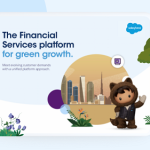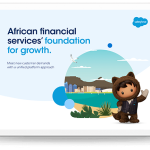Using data to create stellar customer experiences in insurance
Today’s customers are used to data informing — and improving — almost everything they do. It influences the content we consume, the purchases we make, and even who we interact with online. Digitalisation and data shape many aspects of our modern lives and all types of businesses. And the insurance industry is no exception.
Insurance companies can use data to understand what customers want to experience and when. By analysing how customers behave, financial service providers can create an enhanced insurance customer journey.
To understand more about this, Salesforce recently conducted a study into ‘The Future Of Financial Services‘. Through interviewing industry leaders and surveying 2,250 individuals, we discovered what lies ahead for the industry. We also explored how insurance companies can use data to their advantage. Read on to discover how to enhance your insurance customers’ journeys with data.
Getting a complete picture of the customer
You can use data to gain a complete picture of the customer and their journey within your insurance company.
You can collect various data points about your customers, including their:
- History (whether health, driving, or past loss claims)
- Demographic (such as age, gender and location)
- Credit score
- Interactions with your business, including taking out new policies, renewing, or changing account balances
You can analyse the data you collect in different ways to help you better understand your customers and improve how you serve them. You can break this down into three types of analysis:
- Descriptive analytics — looking at what has happened in the past, such as claims history
- Predictive analytics — working out what will happen in the future based on past events or behaviour, such as analysing the likelihood of past illnesses reoccurring when determining life or health insurance
- Prescriptive analytics — identifying the actions that can change the outcome, such as working out what will stop customers from churning
By analysing your data, you can determine risk factors. This allows insurers to efficiently serve low-risk customers the services they prefer at a reduced cost. It also helps insurers identify problematic accounts early on. You can use data to spot the habits that may pose a risk to profitability or customer satisfaction, and then address any issues.
Data also supports insurers in identifying opportunities within the primacy of the customer. You can use data to determine which parts of a customer’s insurance policy are most valuable to them. For example, you can use data to work out which policyholders are more likely to need protection for their families.
By getting a complete picture of the customer, insurers can use these insights to meet customers’ needs. Customers enjoy enhanced experiences, while insurers increase retention and revenue streams.
Learn more about the future of insurance with the Salesforce report
Want to find out more about how to improve customer experiences in the insurance industry?

Track the entire customer journey for stops and starts
Data can help you recognise the points where your customers are getting stuck.
To get a full picture, you need to track all interactions, including logins, article views, chatbot sessions, and more.
Traditionally, the churn rate has been a critical indicator. Of course, it’s still important, but there are many other steps. Advanced data analysis in the insurance industry helps providers recognise the points where the experience is lagging — which could lead to churn.
You can use this journey analysis to predict whether a customer is more likely to leave. For example, if a customer has changed their amount of policies, does this mean they are more likely to leave — and if so, when? You can also identify the more positive stories, such as when a customer may be looking to expand their product portfolio — and how you can secure this new business. You can use data to understand what leads a customer to move from a standard action, such as checking their current policy information, to something more profitable, like taking out additional insurance.
Filling in the gaps in the current customer journey
Data helps insurers recognise the drop-out points and how to fix these.
Once you know where people are dropping off, you can dig further into the data to find out why. One of the data points that can help here is the type of questions customers ask in chatbot sessions.
Many of today’s insurers rely on automation to help serve customers faster. This can be effective and efficient. But it’s easy for you to overlook elements of good service. By analysing common chatbot queries, insurers can improve the automated answers customers receive.
Furthermore, you can see which augmented tools customers use and which ones they don’t. Behavioural data surrounding tools can also help insurers fine-tune them and make them as easy to use as possible. Data makes every change measurable so insurers can see the impact of their changes and continue to improve with every learning.
‘The Future of Financial Services’, which explores how you can create better customer experiences with automation. Read about how you can fulfil the digital-first demand, meet customers where they are, and make better business decisions with better data and new partners.
Learn more about the future of insurance with the Salesforce report
Want to find out more about how to improve customer experiences in the insurance industry?


























